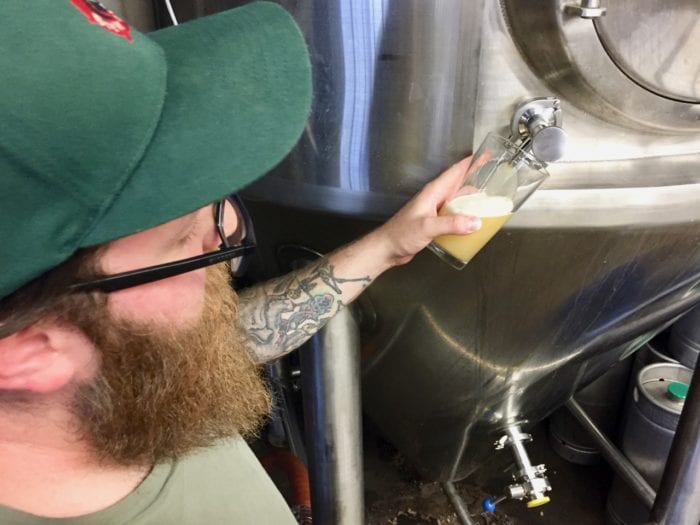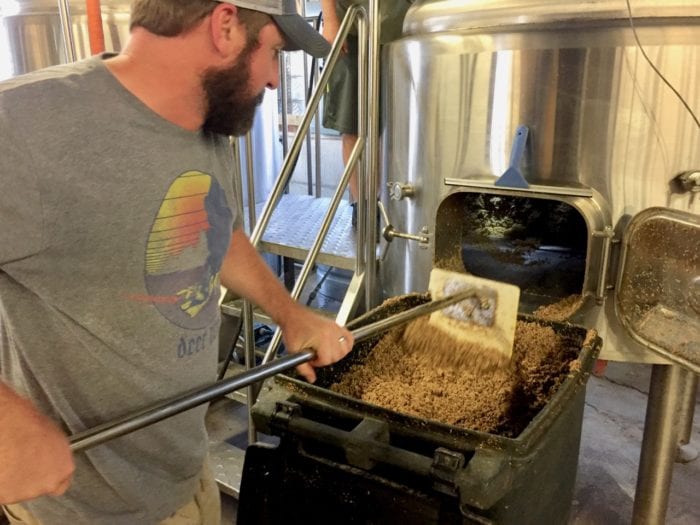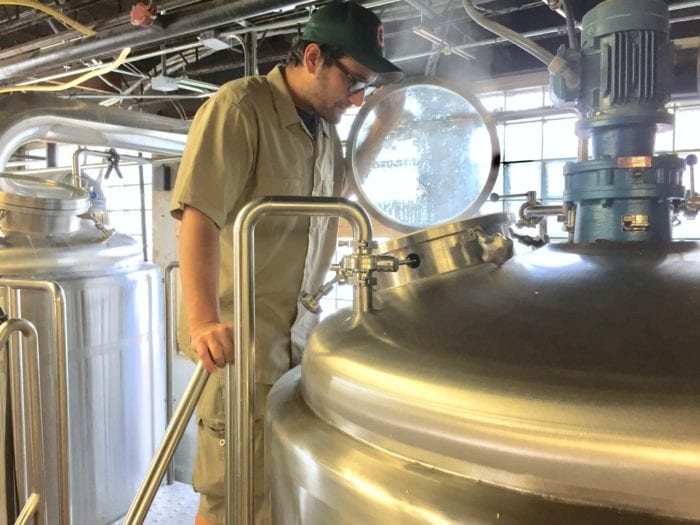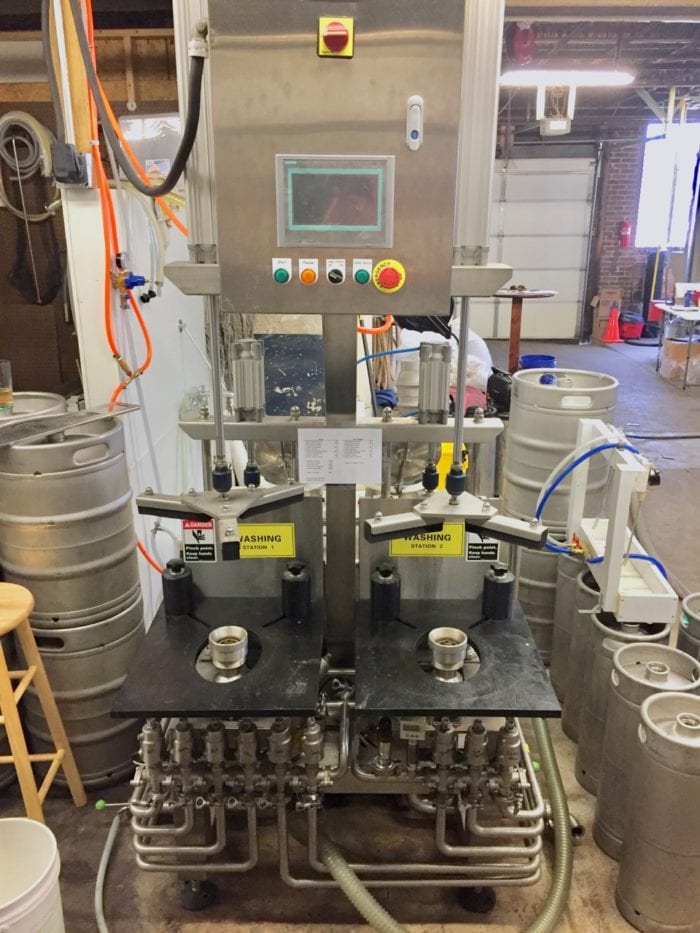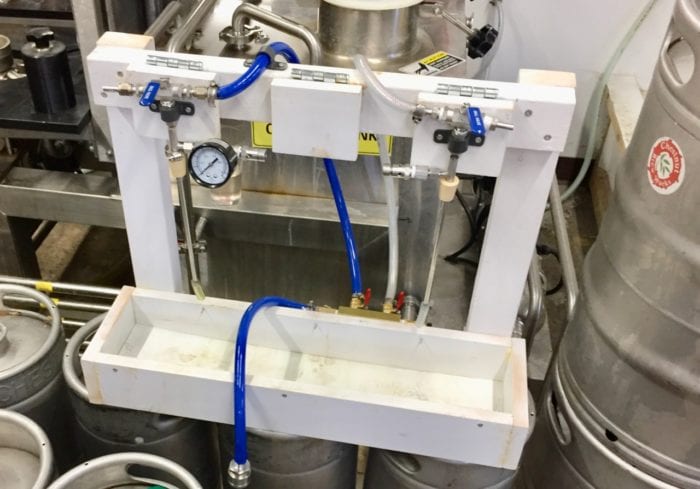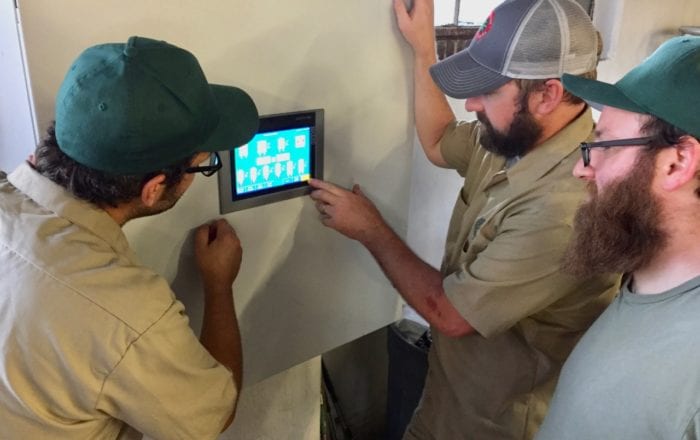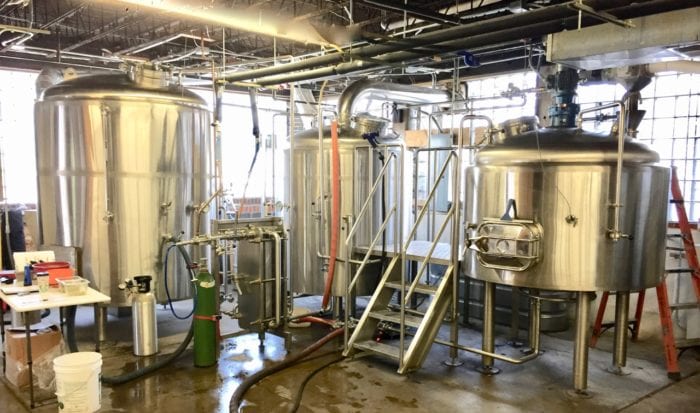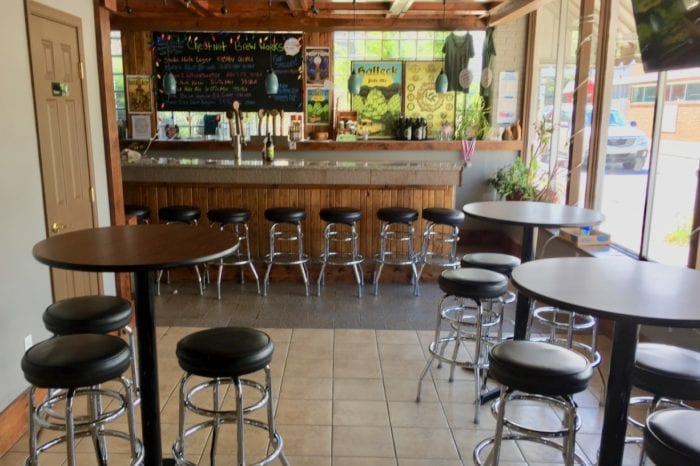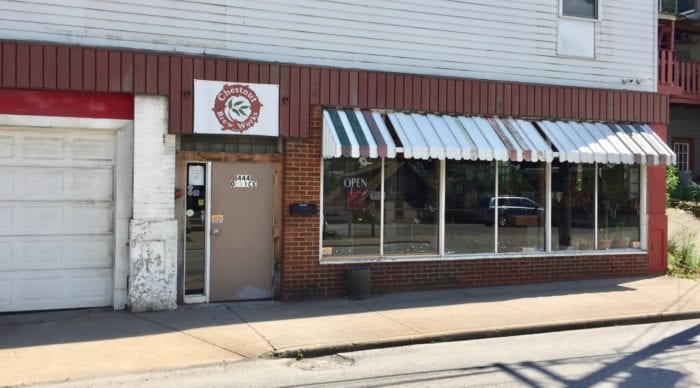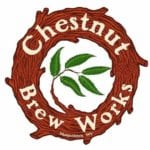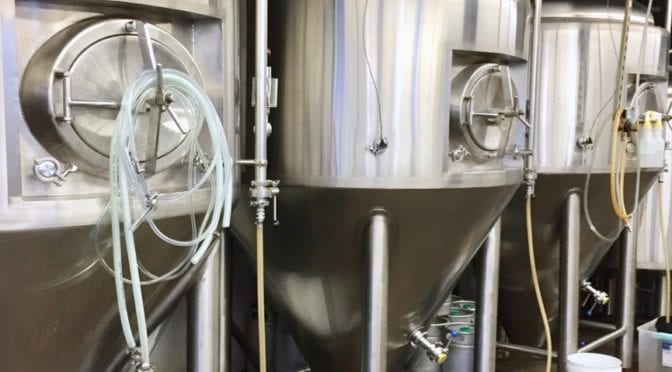
Chestnut Brew Works approaches a crossroads
June 30, 2017
In the fast growing West Virginia craft brewery environment, Bill Rittenour reigns as a senior member of the industry, even though he has only been brewing commercially for four and a half years.

“We started selling beer in April of 2013,” said Rittenour, owner and head brewer at Chestnut Brew Works in Morgantown. “At that time, we were the 7th brewery in the state.”
Today, there are 26.
Inspiring other brewers
Rittenour’s brewery has been a key part of the meteoric rise in the WV brewing scene over the past few years. His success is a huge inspiration to the current crop of new and aspiring breweries. His trajectory from homebrewer to a nano-brewery start-up (in his own garage) to now running a successful 7-barrel brewery, with several employees and a popular taproom, is a shining example of how to develop a small brewery without a starting out with a large investment or taking on a load of debt.

“We started with a one barrel brewhouse, and a few one-barrel fermenters, and a few two-barrel fermenters,” he said of his original operation in a small outbuilding behind his home, about 10 miles outside the city.
He worked on that system for about three months before upgrading to a two-barrel brewhouse. There was no taproom, only Rittenour brewing and regularly delivering a few kegs to a handful of local accounts. Things progressed rapidly, however, and within two years he was opening the current, 7-barrel brewhouse facility on Brockway Avenue in Morgantown’s South Park neighborhood.
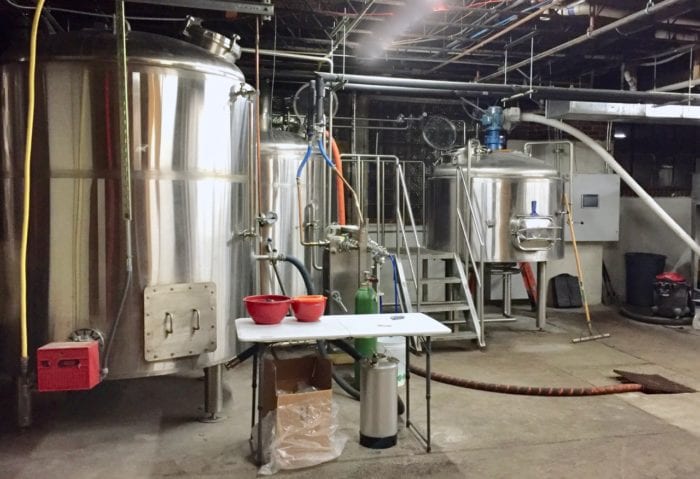
The brewery that Halleck built
How did Rittenour make the step up so quickly? You might say, it’s the brewery that Halleck built.
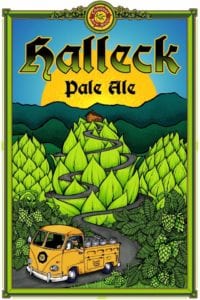
Chestnut Brew Works’ Halleck Pale Ale, and it’s cult-like following among Morgantown bars and restaurants, stands out as an accomplishment any new brewery would love to duplicate.
“It’s a phenomena,” Rittenour said about Halleck.
Several years ahead of the current wave of big-hop-flavored, low-bitterness beers, Rittenour developed the recipe for Halleck while still a homebrewer. It is a beer noted for its beautiful balance and integration of appealing flavors.
“I’ve always liked hoppy beers, but I didn’t like them too bitter,” he said.
He thought other people might like this style too, since he heard so many people say, “I don’t like hoppy beers because they’re too bitter.'”
The thing with Halleck, says Rittenour, is that it appeals to a lot of palates. It satisfies those who appreciate hops. And, it appeals to many people who don’t think they like hoppy beers, but when they taste the citrus and the floral flavors, they love it. They don’t know that those tastes are hops.

When he opened Chestnut Brew Works, the beer quickly became his best seller. It made the transition from his original brewery to the current one, where it’s production volume grew rapidly.
“It started off in a few places and got a following,” he recalled, adding that it just kept growing from there. “Honestly, I still get calls from new accounts, new restaurants, and they always say, we really want Halleck Pale Ale.”
For a brewery that produces several other flagships, Halleck’s popularity can also be a little frustrating. To keep some pressure off Halleck, Rittenour tries to interest new accounts in all the other Chestnut selections, but the response is always the same. While they may order a little of his other beer too, they tell him their customers want Halleck.
“So we have to brew Halleck once a week now,” he says. “If we don’t brew it once a week, then we fall behind. It’s a cool problem to have.”
Letting go leads to more overall control
Don’t let the Halleck focus fool you, Chestnut Brew Works has a book of superior beer, all of which have solid sales track records. The quality of the beer in large part stands as a testament to Rittenour’s talent and intense passion for brewing.
During Chestnut’s first few years. he personally led every brew session. He developed the recipes, brewed the beer, sold the beer, and set the direction for the brewery’s growth. While this passion produced good beer, over time, it was limiting on the brewery’s development and wearing out the owner.
A big part of Rittenour’s growth as a brewer has been his learning to let go and trust the others whom he has trained. A good illustration is his experience with lead assistant Josh Taylor.
“I hired him in June of 2015,” he explained, “and I didn’t let a beer get brewed in this brewery without me present until November 2016. It was hard for me to let go.”
But Rittenour did loosen his grip, and the brewery has prospered. In addition to Taylor, he added assistant brewers Jeremy Morris and Austin Weser.
“It’s been great to step back, but it makes me a little sad sometimes. I get jealous of those guys brewing while I do some of the more tedious business stuff.”
While still brewing from time to time, Rittenour now spends much more of his time taking care of broader business matters such as taxes, accounting, new product development, strategy, marketing, and purchasing. He also gets to spend more time with his children — something that he loves very much.
Moving from a primary focus on brewing to being the overall manager of a growing brewery and taproom operation required Rittenour to make a lot of adjustments and learn new skills. One area of adjustment has been managing employees.
“Managing a few people is a lot different than managing billions of yeast cells,” Rittenour said. “It’s been great though, developing relationships with the employees.
“I got really lucky, I think, in selecting ones that carry the passion of Chestnut and representing the brewery really well. They’re just hard workers who know what needs to be done and really go the extra mile.”
Whether to invest or not
Another thing he’s learned more about is the process of making smart investment decisions for things the brewery needs. Rittenour is fairly conservative in his business approach, and cautious about spending money. He has gotten better at knowing the difference between things that can be put off and things that pay immediate dividends in improved efficiency. Take for instance the commercial keg cleaner, an investment which he initially put off, but then purchased last year.
“I think that’s one of the best investments we’ve had,” he said of the keg cleaner. “It’s gotten us the ability to turn over the kegs quicker. It gave us more time in the brewery to actually make more beer.”
On the other hand, when he wanted to start doing some small batch bottling, he didn’t run out and buy a commercial bottle filling apparatus. He built his own counter-pressure bottle filler instead, at a considerable savings over a small commercial unit. He says it is doing the job well for the time-being.
Other Chestnut brews that shine
The popularity of Halleck Pale Ale does slightly hamper the small brewery’s ability to make and offer all the beers Rittenour would like to see brewed, but they work around it, emphasizing a few rotating seasonals and some occasionals and one-offs.
Among Chestnut’s flagships, a beer that has gained a strong foothold in the local market is Class II Wheatwater. An American-style wheat ale, it is brewed with orange peel and coriander added. According to Rittenour, it’s “selling like hotcakes” this summer, so he has to brew it a lot more frequently now.
Your Best Hoption Double IPA has a strong following year-round with craft enthusiasts and at craft-oriented accounts. As weather cools down sales increase for South Park Porter and Nate’s Nut Brown Ale.
Just about any time of year, things pop up in the taproom, including some of this year’s beauties like Mo-Bel Prize Belgian Dark Strong Ale, Smoke Hole Lager Rauchbier, and Snake Hill Sour Saison.
Smoke Hole Lager was Chestnut’s second-ever dive into the world of making a lager-type beer. It’s a German-style Rauchbier with extremely clean, very defined edges. It had all the qualities a good smokey lager should.
As Rittenour describes it: “It’s got a good campfire/bacon sort of character to it. We went pretty light on the smoke, and it’s dry with a lighter body even though it’s a smoked beer.”
Last year, when he fell upon two wine barrels at a great price, he bought them with the idea that he’d use them to develop his first commercial sour beer. He filled the barrels with a summertime beer called Afternoon Delight Belgian Pale Ale. Afternoon Delight had been brewed with a cupboard-full of spices, including black peppercorns, grains of paradise, orange peel, coriander, cardamom, and ginger. Then he soured it. Wild & Sourful WV was the result.
“We’d been wanting to do a sour for sometime ’cause there’s a huge demand for it from the customers,” he said. “It turned out real solid and real popular.”
A few other notables we’ve seen there include last winter’s Shakedown IPA and the this summer’s Big E’s Small SMaSH! — a session IPA made with a single malt and a single hop.
“It’s all Golden Promise malt and Amarillo hops,” Rittenour says. “It’s light in color and malt flavor, but floral and citrusy from the hops. I just love the simplicity of it.”
That’s why a stop at Chestnut’s taproom is always in order.
Chestnut taproom provides customer contact
Compared to his original brewery where everything was distributed, Rittenour says it’s been nice having a taproom.
“It’s nice to have a place that’s the face of Chestnut Brew Works, however small it is. People like coming in, and we get to talk to them about the beer and the new ones that are coming out and get their feedback. You really hear what people want.”
He says that for the longest time people were coming in and asking when are you going to bottle or can Halleck? He heard it so much that he did some research and built a small, homemade counter-pressure bottle filler. They now bottle Halleck exclusively for taproom sales.
Taproom sales produce margins that are so much better than those for beer sold into distribution. Rittenour says the extra cash flow this generates helps the brewery purchase things like its commercial keg cleaner.
What does the future hold
Rittenour has achieved pretty much everything he originally set out to do.
“My goal in life was just to enjoy what I did and live a comfortable life,” he said. “I’m kind of doing that now.”
So is he content?
The current brewery is pretty much maxed out. Bars in Morgantown want more Halleck. Retail accounts around West Virginia just want any Chestnut beer, but have a very hard time getting them. Distributors call regularly wanting to represent the Chestnut line. Chestnut Brew Works’s popularity is leading it to a crossroads. The question is, will Chestnut Brew Works expand again?
“It is hard to see potential and then not act on that potential,” Rittenour said.
One thing that has him apprehensive about going bigger is the fact that West Virginia’s craft beer market is blowing up with so many new players entering what is, overall, a pretty small market. And he knows if you build a much bigger brewery, you have to brew and sell a ton more beer to make it work financially.
“At what point would I make so much beer that it would become hard to sell that much,” he asked rhetorically.
“So, I don’t know what the next steps are. I’ve decided, if I do take a next step, it’s going to be a big one.”
Rittenour expresses this in a very well though out manner. You can tell it weighs on him. He’s happy where he is. He’s got a good business and a good life. He doesn’t want to mess that up. However, opportunities to expand are definitely on his mind.
“We love doing beer festivals. When we go down to Charleston and Huntington and do beer festivals, people say, ‘This is great. Where can we get it around here?’ And they’re told well, you can’t. Sorry. It’s like a tease. You feel kind of badly.”
While he thinks there is always room in the market for good local beer, he is also seeing the market change and develop. He sees customers being better educated to high quality craft beer tastes by popular regional/national craft brands that have entered the WV market over the past three years. He thinks that nowadays, if you are a local brewery producing just average quality beer, your market may not grow. Being local isn’t enough anymore.
“I think that maybe back when I first started, that if you made mediocre beer, you could be just fine. But now, I think you’re going to get weeded out if the beer isn’t really desired. It’s just going to get harder.”
And for small breweries looking to put beer into distribution — ones wanting to emphasize sales outside their home cities — the emphasis on quality and consistency are radically more important.
Distribution, distribution, distribution
Today, Chestnut exclusively self-distributes and vast majority of its product is sold in the Morgantown metro and nearby counties. The brewery operates its own delivery van and also does dock sales for kegs. Rittenour thinks that, with their small size and current production limitations, signing with a distributor doesn’t make good financial sense. But there is more that keeps Rittenour weary of distributors, who are all much larger businesses than he.
“I kind of wonder where my brand would fit it, especially now, with not only all the breweries in West Virginia, but there’s so many new [out-of-state] craft breweries coming into the state.
“It’s like, where would my brand fit in? Who’s going to sell my brand better than I do?”
That is a question that fills the minds of small brewers around the country who are thinking about whether to grow beyond their local markets. There is no easy answer.
Chestnut Brew Works Profile
Founded in 2013, Chestnut Brew Works began brewing in its current Brockway Avenue facility in January 2015. The taproom opened in April 2015.
Brewery floor size: 2,600 sq. ft. Taproom is about 500 sq. ft.
Annual production: 850 barrels (2016).
The name for the brewery comes from the owner’s interest in saving and restoring the native American Chestnut trees, which were decimated by a blight during the past century. Before starting a brewery. Rittenour earned a PhD in fungal biology, and, yes, was a fungus scientist. Seems like the perfect background to work with yeasts and fermentation.
Chestnut exclusively self-distributes and most all of its product is sold in the Morgantown metro. They have their own delivery van and also do dock sales for kegs. Packaging is primarily in kegs. Halleck 22-oz bottles are sold exclusively at the taproom ($7). Growler fills are sold in the taproom.
Brewing equipment includes a 7-barrel brewhouse with 14-barrel fermenters and 14-barrel brite tanks. They double batch every brew day.
While the brewery floor space is pretty full, Rittenour hopes to install a couple of additional 7-barrel uni-tanks that would help the brewery produce more of its lower-volume brews like Nate’s Nut Brown or the South Park Porter. (Uni-tanks are typically cylindro-conical, jacketed tanks designed for double use as fermenters and as tanks for conditioning and carbonating beer.)


